At the far end of Drishane Cemetery lie the remains of William E. Dennehy, who died serving the U.S. army, a hundred years ago today near the France-Belgium border. He was the second-last Millstreet man to die in World War I, only four weeks before the armistice that finished the war.
Born in Knocknakilla in 1890 to Daniel Dennehy and Margaret Murphy, he had and older brother Jeremiah and a younger sister Mary. Life must have been tough as his father died of TB when he was only three, so it was likely that the family was very poor. His grandfather lived with them until he died in 1906, and by 1911 we know that both boys were working as agricultural labourers. Two years later William moved to Cambridge, Massachusetts where his aunt Mary and her husband Patrick Long (of Aubane) were living. He worked as a leather handler at the Armour Leather Company, and sent what spare money he had back home to support his family, but in 1917 he got drafted into the American army. He didn’t want to go as he stated in his draft registration that he was the breadwinner for his mother and sister. It didn’t matter. From September 1917 he trained in Camp Devens in the 301st Infantry, “Bostons Own”. In June 1918 he became an American citizen, and was transported to war in Europe aboard the S.S. Cedric, leaving New York on July 6th 1918. Landing in Europe the 301st was disbanded, and William was assigned to the 163rd, and two weeks later to the 58th Infantry, part of 8th Infantry Brigade, which was assigned to the 4th Division.
He saw action in Toulon, St. Mihiel, and finally in the Meuse-Argonne offensive, where he was reported missing on October 7th 1918 at Bois de Fays, about 3km west of the town of Brieulles-sur-Meuse.
He was buried there, but the American public wanted their fallen boys brought home. The French blocked the repatriations for three years, but relented, and eventually on May 21st 1922, sixty-four US soldiers of Irish birth arrived in Dublin at the request of their families. William was one of those, and he was brought to Millstreet and given his final resting place in Drishane Cemetery.
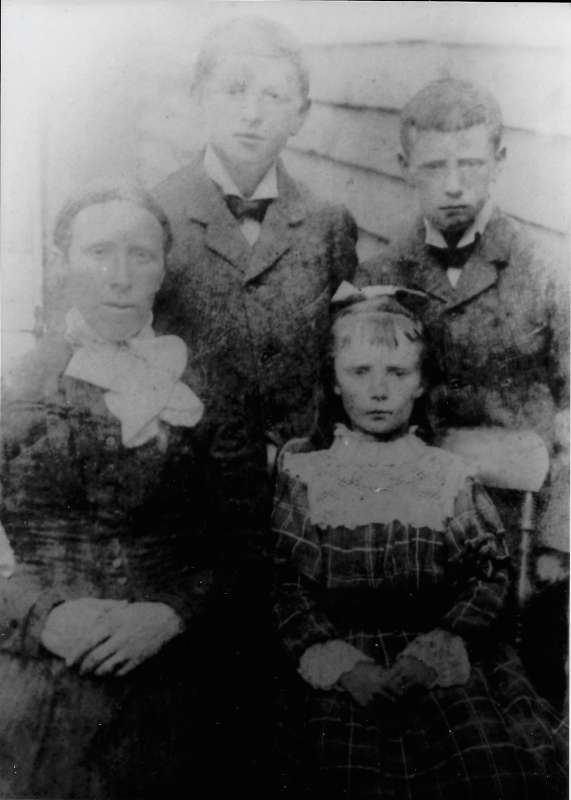 The Dennehy family around 1900. Left to right: Margaret (mother), Jeremiah, Mary, and William
The Dennehy family around 1900. Left to right: Margaret (mother), Jeremiah, Mary, and William
====
WILLIAM’S FAMILY
Parent’s Marriage: Marriage of DANIEL DENNEHY of LAKDOTA and MARGARITA (MARGARET) MURPHY of KNOCKNAKILLA on 29 May 1888 – Daniel is the son of Jeremiah Dennehy and Mary Murphy, Margaret s parents William Murphy and Mary Quill.
In other family documents William and Mary Murphy were in Glantane (near Keim, and Cushloura (Mushera Beg )
Birth of JERERMIAS (JEREMIAH) DENNEHY of KNOCKNAKILLA on 21st March 1889 [baptism 22nd March 1889]
Birth of GULIELMUS (WILLIAM) DENNEHY of KNOCKNAKILLA on 7 July 1890 to Daniel Dennehy and Margaret Murphy [baptism: 8th July]
Birth of MARIA (MARY) DENNAHY of KNOCKNAKILLA on 20th February 1892 [baptism 24 February 1892]
Death of Daniel Dennehy (1838–1893) (Wiliam’s father) on 9 March 1893 at Knocknakilla, from TB (a year and a half), in the presence of his father-in-law William Murphy
1901 census: Residents of a house 7 in Knocknakilla (Coomlogane, Cork). Margaret’s father William, a Dairyman is living with the family. He had been a widower since 1879).
| Surname | Forename | Age | Sex | Relation to head | Religion |
|---|---|---|---|---|---|
| Murphy | William | 70 | Male | Head of Family | Roman Catholic |
| Dennehy | Margaret | 39 | Female | Daughter | Roman Catholic |
| Dennehy | Jeremiah | 12 | Male | Grand Son | Roman Catholic |
| Dennehy | William | 10 | Male | Grand Son | Roman Catholic |
| Dennehy | Mary | 9 | Female | Grand Daughter | Roman Catholic |
1906 Death of William’s grandfather William Murphy of Knocknakilla, from a cerebral haemmorage 2 days. Daughter Margaret Dennehy present at death.
1911 census: Residents of a house 7 in Knocknakilla (Coomlogane, Cork). Jeremiah and William are working as agri laboursers. Where is Mary?
| Surname | Forename | Age | Sex | Relation to head | Religion |
|---|---|---|---|---|---|
| Dennehy | Margaret | 50 | Female | Head of Family | Roman Catholic |
| Dennehy | William | 21 | Male | Son | Roman Catholic |
| Dennehy | Jeremiah | 22 | Male | Son | Roman Catholic |
Jeremiah Dennehy married Julia Butler (Liscahane) in 1926.
Further family information is on Mary’s Ancestry profile
==
IMMIGRATION TO AMERICA
Aged 22, William left Queenstown (Cobh) on May 21st 1913 on board the S.S. Arabic, and arrived in Boston on May 30th. His listed destination was Cambridge, Massachusetts, his passage paid by his aunt, and he was to stay with her: Mrs Patrick Long, 401 Columbus St, Cambridge. Height 5’8″, fair hair, blue eyes.
In Cambridge he lived with his aunt Mary, her husband Patrick Long (of Aubane) who worked as a bartender in a liquor store, and Patrick’s sister Catherine. He worked as a leather handler at the Armour Leather Company at 23 Sleeper Street in Boston.
His emigration was an economic one, because he was to send what spare money he had back home to support his mother and sister, but that plan was torn apart when in 1917 he got drafted into the American army.
401 Columbis St, Cambridge, MA [Street View]
The Armour Leather Company was burned down in 1947. Here are some photos.
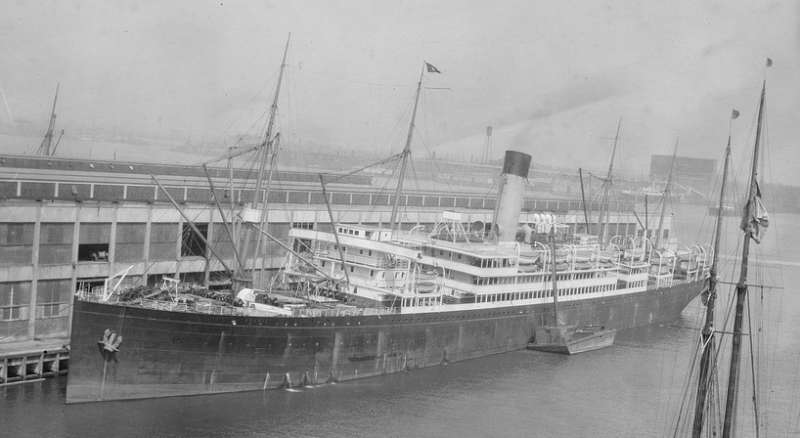 The S.S. Arabic on which William went to Boston from Queenstown. Pictured at South Boston Pier 1918 [1]
The S.S. Arabic on which William went to Boston from Queenstown. Pictured at South Boston Pier 1918 [1]
==
DRAFTED INTO THE ARMY
Following the Selective Service Act of 1917 every man without dependants between the ages of 21 and 30 had to fill out a draft register card at a booth in his city or town, and he received a number. A month later numbers were pulled in Washington and if your number came up, you were drafted. You received a letter from an exemption board ordering you to appear for examination. If physically fit, you were passed by the doctors. Several weeks later you received another letter, ordering you to report at the board office at eight o’clock the next day. From there you were marched to the station and onto a train to take you to camp.
This is William’s Registration Card:
Draft Registration Card: Name: William Edward Dennehy, 26 yrs; Home Address: 401 Columbia St, Cambridge, Mass; Birth Date: 5 Sep 1890; Residence status: Declared intentions 1917; Where were you born: Millstreet, County Cork, Ireland; Country of Citizenship: Gt Britain; Present occupation: Leather Handler; Employee: Armour Leather Company; Where employed: 23 Sleeper St. South Boston; Those dependent on you for support: Mother and sister; Marital Status: Single; Race: Caucasian; Military service: none; Do you claim exemption from draft? Yes, mother & sister; Height: Tall; Build: Medium; Eyes: Blue; Hair: Light Brown; Bald: no; Disabled? no
Signed Howard S. Knowler; Precinct 4, Ward 3, Cambridge, Middlesex County, Mass. June 5th 1917
=====
AT CAMP DEVENS
At Camp Devens men from the same localities throughout New England were to be placed in the same outfits, insofar as it was possible, and on the heels of this information came the table of organization for the 76th National Army Division. William joined on September 20th, and probably arrived on September 23rd, where he was placed with the 301st Infantry, which later became known as “Boston’s Own” regiment, with men from Boston, Brookline, Cambridge, Chelsea, Everett, and Winthrop, under Colonel Frank Tompkins, seconded by Lieut-Col Percy W. Arnold.
Transfers: William moved companies twice while at Camp Devens:
- Entered 20 Sept. 1917, Co. F, 301st Inf., 76th Div.
- Transferred 19 Mar. 1918, to Hq. Co., 301st Inf.
- Transferred 24 May 1918 to Co. H, 301st Inf;
A big day: On Oct 26th 1917, the Boston Regiment received visitors. Headed by Mayor James M. Curley, the City Fathers and nearly one hundred other visitors came to Devens to see the boys from Boston. The regiment was brought out and put through its paces. It was on that occasion that the men of the 301st Infantry were addressed collectively by their colonel, Frank Tompkins, for the first time. It was a message that none of them who are still alive will ever forget, for it was the talk of one fighting man to a large group of men of his own timber.
“I want you men to know that I consider you have delivered the goods,” said Colonel Tompkins. “I know you will continue your splendid work until the end and after. I expect you Boston men to write your mark deep in the breast of the Hun.”
And they did it, too; but not as the 301st Infantry.
Mayor Curley spoke, and when he had finished the flag of the city of Boston was presented to the regiment. It was received by Color Sergeant James H. Connolley, who had formerly been a Brookline policeman. It was taken to France and is now safely back in Boston. [Forging the sword page 70]
Going to War: At 3 o’clock on the afternoon of July 4th 1918, the 301st Infantry, Boston’s Own Regiment, cheered itself away. In long sections of coaches the trains rolled at short intervals down through the town of Ayer in broad daylight. This regiment placarded the doors of their Devens homes with the names of familiar Boston Hotels. One sign read :”Hotel Touraine Closed by Order of the Licensing Board.”
More on Camp Devens:
- Camp Devens – Described and Photographed
- Forging the sword; the story of Camp Devens, New England’s army cantonment
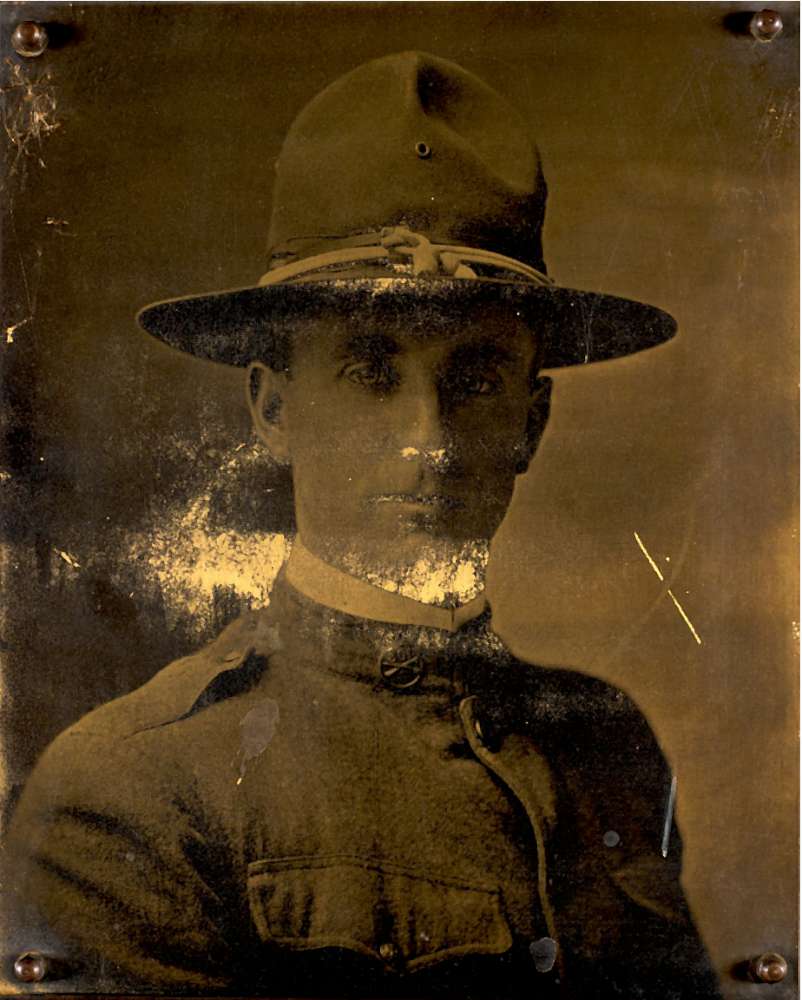 William Dennehy World War I Memorial Plaques at the Cambridge Public Library. This was likely taken at Camp Devens while he was in training.
William Dennehy World War I Memorial Plaques at the Cambridge Public Library. This was likely taken at Camp Devens while he was in training.=====
WILLIAM’S NATURALIZATION IN CAMP DEVENS
William signed a Declaration of Intention to Naturalize on April 26th 1917 in Boston. His Petition for Naturalization happened in Camp Devens on June 1st, 1918, and his Naturalization was completed in Camp Devens on June 24th, 1918, with thousands of other soldiers, before they were sent abroad to fight.
This is how the Naturalizations took place in Camp Devens: “Naturalization of all aliens in the division started on Monday morning, June 24, so that all the men who went across in the division might go as fully fledged American citizens. Precedents were shattered all to blazes in order that this might be done, and the Federal District Court sat for the first time in its history outside a conventional court chamber.
The first naturalization ceremony was an impressive one. Judge James H. Morton, Jr., came to Camp Devens and opened court in the Y. M. C. A. Auditorium, sitting on a camp chair and presiding from behind a kitchen table. Before him stood 800 men seeking citizenship — the first of 5,500 to be so naturalized — and every man dressed in an American uniform, ready to pledge their allegiance and their lives to the United States. At a signal from the court officer, those tanned and brawny hands shot into the air and they took the oath of allegiance to Uncle Sam. Then they listened to an inspiring speech by Judge Morton. Italians, Russians, Turks, Portuguese,
Norwegians, Greeks, Swiss, Belgians, Swedes, Roumanians, Dutch, Persians, Austrians and subjects of Great Britain walked into that court. American citizens and soldiers walked out.”
It is worth reading Forging the sword; the story of Camp Devens, New England’s army cantonment to give a better understanding on what was needed to get soldiers ready for war.
====
TRANSPORTATION TO EUROPE
On July 6th 1918, he was transported from New York to Europe on board the S.S. Cedric as part of Company “H” 301st infantry. #1656927 Private; Mrs Patrick Long, Aunt, 401 Columbia St., Cambridge Mass
The 301st Infantry Regiment arrived in France on July 24th 1918, and on arrival found that the division had been designated by the American Expeditionary Force as one of six Depot Divisions to receive, train, and process replacement troops. Essentially the 76th Division was to be split up to fill the depleted ranks of other units.
William was assigned to the 163rd Infantry on July 31st, a Depot Division, where he trained for two weeks before joining the Company “I” of the 58th Infantry on August 12th.
The 58th was part of the 8th Infantry Brigade of the 4th U.S. Division, which was involved in the St. Mihiel and Meuse-Argonne campaigns. The 4th or “Ivy” Division was very roughly handled in the Argonne, suffering severe casualties (12,948). A good recent book on the battle is To Conquer Hell by Edward G. Lengel. – greatWarForum
====
TOULON (LORRAINE) DEFENSIVE
(6th-9th Sept)
This was a defensive position designed to stop forward movement of the Germans. The 58th, were used in a reserve position behind the 59th Infantry.
Saint Mihiel
(9–16 Sept 1918)
The attack at the St. Mihiel salient was part of a plan hoping that the Americans would break through the German lines and capture the fortified city of Metz. The attack caught the Germans in the process of retreating.This meant that their artillery was out of place and the American attack, coming up against disorganized German forces, proved more successful than expected. The St. Mihiel attack established the stature of the U.S. Army in the eyes of the French and British forces, and again demonstrated the critical role of artillery during World War I and the difficulty of supplying such massive armies while they were on the move. The U.S. attack faltered as artillery and food supplies were left behind on the muddy roads. The attack on Metz was not realized, as the Germans refortifie.
Sept 9-13th: The general mission of the 8th Infantry Brigade in St. Mihiel was to insure the occupation and defense of the sector, holding the outpost position in case of local attacks and the main line of resistance in case of a general attack. The 58th lost only one soldier in the week around St.Mihiel.
Sept 13th-15th: 4th Division had directed the 8th Infantry Brigade to push patrols into Bois de Manheulles, Manheulles and Fresnes, in order to determine how strongly those places were held. If found to be lightly held, the towns were to be occupied with small detachments. Contact was to be gained, if possible, with French advance posts to the left. This had been done in part on September 13. As a result of this action (and other parallel action) the enemy was driven back from his outpost positions in Manheulles and Fresnes, where the 8th Infantry Brigade established its outposts. The main line of resistance remained unchanged. Liaison with the 15th Colonial Infantry Division was established in Champion by a patrol of Company I. This company also established liaison with the company in Manheulles. No concerted attack was made by the 10th Colonial Infantry Division, with which the 8th Infantry Brigade was in liaison. The relief of the 8th Infantry Brigade by the 15th Colonial Sept. Infantry Division, begun on the night of September 14-15, was was completed during the late afternoon of September 15.
Description of the Battle of St.Mihiel [Revolvy] [4th Division – Summary of Operations pages 35-45]
====
VIDEOS OF THE 58TH in FRANCE
Follow the links below to see the 58th in action in the early stages of the Meuse-Argonne offensive at the end of September 1918, a week or two before William was killed:
====
WHAT HAPPENED TO WILLIAM AT BOIS DE FAYS?
Bois de Fays – ‘Wood of Fairies’, or as it became known, the ‘Centre of Hell’
We will probably never know exactly what happened. William was reported missing on October 7th. At the time they were trying to take a number of forested hills, which were heavily fortified and strongly defended. On the 6th/7th, his company came under heavy counter attack. There were many casualties, much of which was because a lot of gas shells rained down on them at Bois du Fays. It makes for harrow reading. Below are a few reports that outline the activities of the 4th Division that William was attached to:
The 4th Division attempted to drive ahead through three patches of woodland, the Bois de Fays, the Bois de Malaumont, and the Bois de Foret. If successful, the advance would drive a wedge into the eastern end of the Kriemhilde Stellung, allowing the division to seize Brieulles and push west along the Heights of Cunel. The 80th Division, having presumably breached the German positions in the Bois des Ogons, would simultaneously attack the heights from the south.
General Hines ordered the Ivy Division’s 58th Regiment to lead the attack across an open ravine and into the Bois de Fays. The Doughboys jumped off at dawn behind a rolling barrage of shellfire from French 75s that raced quickly ahead through the Bois de Fays, while French tanks rolled and coughed alongside. Mist wreathed the ravine, limiting visibility to about two hundred yards. A promised smoke screen failed to appear on the right, how-ever, and the fog lifted quickly. Halfway across the ravine, German observers spotted the Americans. The enemy artillery, which had been pounding the 4th Division’s lines of supply, redirected its fire against the infantry and in-flicted severe casualties while knocking out most of the tanks.” The infantry found the fighting in the Bois de Fays more to their taste. Instead of just serving as targets for German shells, they could hit back. Ger-man snipers and machine gunners received no quarter as the Doughboys slashed forward through the Bois de Fays and the Bois de Malaumont, crossed the Cunel-Brieulles road, and pushed toward the southern edge of the Bois de Foret. The surge didn’t last long, however, before the German ar-tillery regained, the upper hand. The 58th’s right flank dangled in the open. It had also badly outpaced the 80th Division to the left, leaving it in a danger-ous salient. German field artillery plastered the Americans with high explosive and shrapnel, while heavy howitzers from east of the Meuse shook the ground with explosions that sent columns of dirt and debris hundreds of feet into the air. Gas shells fell in profusion, splashing the woods and fields with Mustard gas and creating billowing clouds of phosgene. The Doughboys had to fight in their masks, making it more difficult to spot enemy snipers and machine gunners. German shellfire fell with particular fury on the ravine south of the Bois de Fays, isolating the 58th’s first waves from their support. No reinforce-ments or ammunition could be brought forward into the woods. Enemy air-planes swarmed like hornets, strafing, bombing, and directing the German artillery. Mitchell’s fliers were invisible—as usual—and the German planes just kept coming despite the efforts of antiaircraft machine guns.” Attacked from above and on almost every side, the Doughboys withdrew to the north-ern edge of the Bois de Fays, leaving only a few outposts in the Bois de Malaumont. Sensing weakness, the German infantry counter-attacked immediately; but the Ivy pivision’s officers did a superb job of preparing their positions. As a reinforced company of Germans approached the eastern edge of the Bois de Fays, entering a small valley just outside the woods, American machine guns laid a swath of fire just behind them. American riflemen simultaneously worked toward the valley’s edge, raking the Germans flank and routing them completely. Unheeding their officers’ orders to halt, many Doughboys pursued, capturing or bayoneting several Germans, but their impetuousity carried them too far. Caught in open ground toward Brieulles, the Americans took heavy casualties from German machine guns before their officers shepherded them back into the Bois de Fays.” The next two weeks were the worst the Doughboys ever experienced. “It is said,” wrote Sergeant Major James Block, “that the Bois de Fays means ‘Woods of the Fairies: Were I to name it, I would call it ‘The center of Hell’. Any man who ever spent any time in those woods from the 4th to the 17th of October, knows that even that term does not adequately express the true situation.”
The shell torn woods were wet and muddy; everything was wet and damp, raw, cold and clammy. Not a breeze blew to clear the gas laden air. The sun never shown, it was always dark and murky. Down the sides of our fox holes, water trickled or seeped through the walls. From all sides came the odor of death or decay, mangled bodies of men everywhere. Our bodies ached from the cold and wet. The foul surroundings made one sick at heart. We were hungry, yet unable to eat but little of the food which came up. For hours at a time we were forced to be without water, for to go after it was to gamble with death. The mental strain was maddening, the physical strain exhausted us, yet we had to be alert. Sleep was impossible. The enemy counter-attacked time and again, but was repulsed each time…. When the Roche were not counter-attacking, they were shelling our positions. We had to lay there and hold. We had to take all the punishment with our hands tied.”
Such horrible realms of experience forever separated the Doughboys from the desk-bound generals under whom they served. Men like Pershing and Bullard, who never set foot in a place like the Woods of the Fairies, could not understand how it sapped drive and morale. [To Conquer Hell: The Meuse-Argonne p199-201]
Many changes had been made in the front-line divisions and on October 4 the Army order of battle from the Meuse River to the west was as follows: the 33d, 4th and 80th Divisions in line in the III Corps; the 3d and 32d Divisions in line and the 91st Division in process of withdrawal from line to reserve in the V Corps; and the lst, 28th and 77th Divisions in line with the 82d, 92d (Jess the 183d Brigade) and French 5th Cavalry Divisions in reserve in the I Corps. The 35th and 42d Divisions and the 183d Brigade of the 92d Division were in Army reserve. The attack was launched with great force about daybreak. The resistance encountered was desperate in the extreme as the Germans were rapidly pouring their best troops into this battle. Not all the assigned objectives were taken, but important gains were made, outstanding among them being the capture by the 4th Division of the Bois de Fays in the Hindenburg Line southeast of Cunel and a deep advance immediately east of the Aire River by the lst Division. [American Operations in the Meuse-Argonne]
The first phase of the Meuse-Argonne offensive, from September 26 through October 3rd had swept through the first two lines of German defenses. The second phase of the battle was to penetrate the German main defensive position, the Kriemhind-Stellung, The objective assigned to the 4th Division was to hold the northern edge of the Bois de Brieulles, and then advance through Bois de Fays and Bois de Malaumont, and then turn east and sweep the Bois de Foret to the Meuse River.
On the morning of October 4, troops of the 58th began to advance and establish themselves by late afternoon in Bois de Fays. The advance was marked by intense fighting and counterattacks plus heavy bombardment including the use of gas shells. By the evening of the October 4-5, the division had advanced to the eastern edge of the Bois de Fays. From October 6-8, the situation remained unchanged. On October 9, Pershing decided on another major push, and III Corps ordered the 4th and 80th divisions to advance. The 4th Division was spearheaded by the 39th Infantry. After a day of heavy fighting, the advancing troops had cleared Bois de Fays and taken a small section of the trenches at the southwest corner of the Bois de Foret. It was during this period that MajGen. Cameron took command of the division again, when General Hines was transferred to command III Corps. – [US in the first world war page 628]
The only other element of the 33rd Division on that side of the river was the 3rd Battalion, 132nd Infantry, and its machine gun company, with the 4th Division in the Bois du Fays* On the 10th it participated in the attack against the Bois de Foret, advancing to the northern edge of the wood, and holding its position until relieved by the 3rd Division on the 13th. In its week with the 4th Division, the battalion lost 1 officer and 37 men killed, 11 officers and 315 men wounded and gassed. The machine gun company commander was to say that “due to the enemy alternating high velocity shells with gas,” 105 of his 130 combat men had become casualties during that week. – 33rd infantry division
Maj Bullington: “I have had 9 officers and about 160 men casualties. Located in Bois de Fays. My doctor and first aid people were all gassed and have gone to the hospital.” – 33rd infantry division page 57
From a report on Action of the Machine Gun Comany, 132nd Infantry, while Holding Salient in Bois de Fays from October 6th to 12th 1918:
On the afternoon of October 7th, I was advised by runner that the enemy was attacking on our right front, occupied by Company “M”, Who asked for machine gun support. I instructed sergeant dean to go forward with one gun and crew, reporting on his arrival to Lieut Yangle. Received another report by runner that the enemy was attacking in force. I immediately ordered “Stand by Reserve Guns”. The minenwerfers on the right flank then opened, making the position of the machine guns in the right flank untenable, one shell mortally wounding Private Scalzetti. Upon consultation with the Commanding Officer, Company “I”, we decided to with draw the troops to a better position in the wood, leaving an observation post and keeping in touch with Company “M” by means of connecting files. We were advised that the American Artillery would bombard the woods on our left front. The bombardment being in the nature of a searching and traversing fire, I was advised by Lieut. Williams that it would be necessary to withdraw the first sections of his platoon from its position. I, on the contrary decided to allow it to remain. It was subsequently cut off from all communication for about two hours. The section suffered only one casualty, Private Powers being slightly wounded on the left hand. The enemy then opened a terrific bombardment, causing a number of casualties in the infantry companies. The nature of the terrain to our read precluded any possibility of establishing a First Aid Station in our immediate vicinity. I then suggested to the Battalion Commander that a detachment of the Hospital Corps be sent up to our position to establish an Advanced First Aid Post. These men camp up that night. During the entire day of the 8th wounded kept coming in. – Commanding Officer 132 Infantry
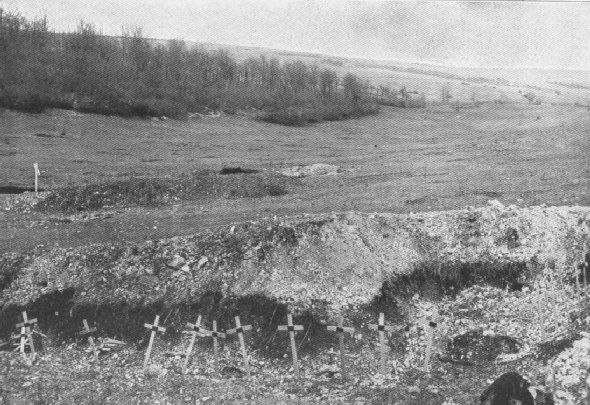 American graves in trench on southeastern edge of the Bois de Fays. Near Brieulles-sur-Meuse. [1]
American graves in trench on southeastern edge of the Bois de Fays. Near Brieulles-sur-Meuse. [1]
Bois de Fays [Google Maps]
It’s also interesting to see photos of the German fortifications on top of the hill at Bois du Fays
 Wounded, Died of Wounds, and Killed in Action, of William’s 58th Infantry in the Meuse-Argonne Offensive [4th Division – Summary of Operations page 45]
Wounded, Died of Wounds, and Killed in Action, of William’s 58th Infantry in the Meuse-Argonne Offensive [4th Division – Summary of Operations page 45]
====
REPORTED MISSING IN THE BOSTON GLOBE
(November 18, 1918)
William E. Dennehy. reported missing, was in Co I, 58th Infantry. He is 27 years old and resided with his sister, Mrs Patrick Long, at 401 Columbia st, Cambridge. His mother, Mrs Margaret Dennehy, lives in Ireland. He was assigned at Camp Devens to Company H, 301st Infantry, “Bostons Own”, but was transferred to the 58th and went across last summer. The telegram to his sister says he was reported missing in action Oct 7. [Boston Globe]
Memorial Mass in Cambridge for St.Mary’s patriotic dead
(March 1st 1919)
====
GOLD STAR RECORD
Dennehy, William E.: killed in action 7 Oct., 1918 [Bois de Fays]. Ent. ’20 Sept., 1917, Co. F, 301st Inf., 76th Div.; trans. 19 March, 1918, to Hq. Co., 301st Inf.; 24 May to Co. H, 301st Inf ; 31 July to Co. B, 163d Inf., 41st Div.; 12 Aug. to Co. L 58th Inf.,4th Div. Overseas 6 July, 1918.
Born 1890, at Knockanilla, County Cork, Ireland, son of Mrs. Margaret Dennehy; brother of Jeremiah and Mary. All of Knockanilla, Ireland. Employee of the Armour Leather Company. Resident in Massachusetts four years. – Commission on Massachusetts’ Part in the World War.
====
SERVICE RECORD CARD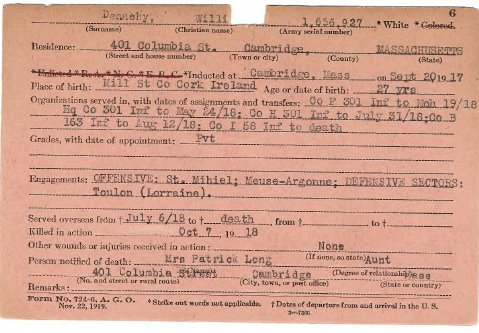
====
BRINGING HOME THE U.S. WAR DEAD
(and the politics involved)
When World War I concluded in 1918, U.S. military leaders balked at the effort to recover the bodies of its fallen soldiers. And no wonder. Initial estimates suggested that more than 70,000 men had been buried in temporary battlefield graves. Even the relatively small efforts to reclaim the few thousand dead from the previous foreign conflicts had been costly and difficult.
Families grew increasingly intolerant as the passing months brought no evidence of any effort being made to return their loved ones. Their impatient pleas began arriving at the War Department within days of the cease-fire, with friends and families clamouring for the return of the war dead. Yet the government had entered the conflict in April 1917 with no clear measures for coping with the remains of the deceased. But the families of the fallen men demanded that they be returned.
U.S. allies were horrified at the idea of Americans digging up their dead and shipping them home. The British government worried that its own people would demand the same for its more than 700,000 dead. French leaders, meanwhile, envisioned ghoulish trains packed with bodies crisscrossing their countryside. Arguing that France had to concentrate on rebuilding, they banned removal of bodies for three years.
In late 1920, the French finally yielded to American pressure and lifted their ban on the return of bodies. Once plans were arranged for their return, transportation of bodies across France became a logistical nightmare requiring a generous allowance of trucks, canal boats, and railway cars. Coffins had to be procured and more labour was required to complete the task on a time scale that would keep the American public content. Yet, despite the government’s best attempts to deny allegations against its efficiency, accusations mounted as press surveillance reports struggled to meet the demands of an increasingly suspicious public. Numerous cases of mistaken identity were reported by families who claimed to have received the wrong body (while others were promised remains that never arrived).
The United States spent the next two years and more than $30 million—$400 million in today’s dollars—recovering its dead. The remains of 46,000 soldiers were returned to the States at their families’ request, 764 to European places of birth, while another 30,000—roughly 40 percent of the total—were laid to rest in military cemeteries in Europe. [ref]
For more indepth details on the repatriation of the bodies read these articles:
- Rest in Peace? Bringing Home U.S. War Dead (historynet.com)
- Bringing home the bodies, after World War I and today (fromthesquare.org)
- or read the book Bodies of War: World War I and the Politics of Commemoration in America, 1919-1933
====
SAD HOMECOMING
(The Freeman’s Journal, Monday May 8, 1922)
Irish American Soldiers Who Died In France – Sixty Four Bodies From The Battlefields. [1]
The bodies of sixth-four American soldiers, men of Irish birth, arrived in Dublin at noon yesterday on board the S.S. Millwater, having been exhumed from graves on French battlefields for re-interment in Irish soil.
Claimed by relatives for burial in Ireland, the United States Government arranged for the removal of the bodies from France.
It is understood that the work of unloading the caskets will be commenced this morning, and the bodies will be removed to a City mortuary for storage pending their transfer by rail to their various destinations. Captain W. R. Buckley, U.S. Army, told a ‘Freeman’s Journal” representative that no ceremony will mark the landing of the bodies.
Accompanied by four conveyors, Captain Buckley has arrived in Dublin in connection with the shipment, and will remain in Ireland till all the bodies are delivered. The names of the conveyors are: Messers. Johnston, Stewart, Williams and Royed.
SALUTING THE DEAD
The S.S. Millwater, which is a a small British coasting vessel, owned in Ipswich, received the caskets at Antwerp. Mr. Richard R., Willey, U.S. Vice-Consul at Dublin, was among those present when the vessel berthed at City Quay.
During the day the vessel was the centre of much interest, and those passing up and down the Liffey-side reverently saluted the remains, which are ranged in the holds of the vessel.
A number of relatives of the deceased have arrived in Dublin for the purpose of accompanying the remains on their last homeward journey.
Every province and practically all the counties are prepresented among the dead, which include Rev. Patrick J. Gallagher, Knights of Columbus Chaplain, whose body is consigned to Mr. James Galagher, Castlebar, Mayo.
HONOURED NAMES: The names and destination of the dead are as follows … [Goldenbridge Inmate 39][Clare Library]
 The S.S. Herbet Walker was originally launched as the S.S. Millwater in 1920 [details]
The S.S. Herbet Walker was originally launched as the S.S. Millwater in 1920 [details]
====
THE HEROIC DEAD – IRISH SOLDIERS REMAINS ARRIVING IN DUBLIN
The remains of the 64 bodies (including William E Dennehy) on the S.S. Millwater left Antwerp, Belgium on May 2nd and arrived in Ireland on May 7th:
Dublin, Saturday, – the S.S. Millwater is expected with the bodies of sixty four American soldiers – men of Irish birth – killed in the Great War.
Claimed by relatives for burial in Ireland, the United States Government arranged for the exhumation of the bodies in France and their transportation for re-interment in Ireland.
Captain W.R. Buckley, U.S. Army, accompanied by four conveyors, has arrived in Dublin in connection with the shipment, and will remain in Ireland toll all the bodies are delivered.
Relatives will be notified of the hour and train on which they will arrive, but the caskets will remain sealed and no facilities granted for viewing the remains.
Mr Richard R. Williams, U.S. Vice-Consul at Dublin, will be present to represent his Government on the arrival of the Millwater at the South Wall. There will be no ceremony to mark the landing of the bodies.
Every provence and practically all the counties are represented among the dead, which include Rev. Patrick J. Gallagher, Knights of Columbus Chaplin, whose body is consigned to Mr. James Gallagher, Castlebar, Co. Mayo… [1]
May 1922 Remains of 64 Irish-born US Soldiers Killed in WWI Arrive in Dublin List @irishacw @k72ndst pic.twitter.com/TccZAMp8oH
— Jean Prendergast (@Cork1914to1924) June 19, 2017
====
WILLIAM’S FINAL RESTING PLACE
William’s final resting place is in the family plot in Drishane Cemetery, on the opposite side of the cemetery from the entrance gate.
[Historic Graves] [Find a Grave]
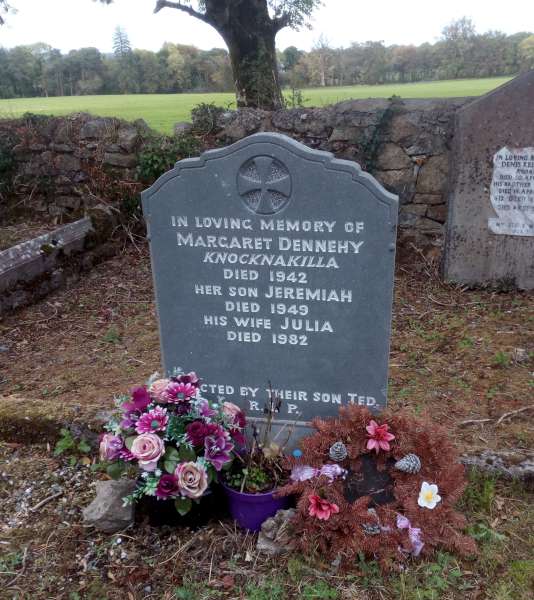 Margaret, Jeremiah, and his wife Julia are buried in the same plot as William and Mary in Drishane. The two headstones face each other. [Historic Graves]
Margaret, Jeremiah, and his wife Julia are buried in the same plot as William and Mary in Drishane. The two headstones face each other. [Historic Graves]
====
Many thanks to Mares Fitzgerald great niece and her aunt Phyllis Humphries (Williams niece) for the use of the family photo … but mostly thanks to someone else who would prefer to remain anonymous, because without her, we’d never have been able to put this article together.
====
Update: The Cross-post on Facebook has lots of interesting comments.


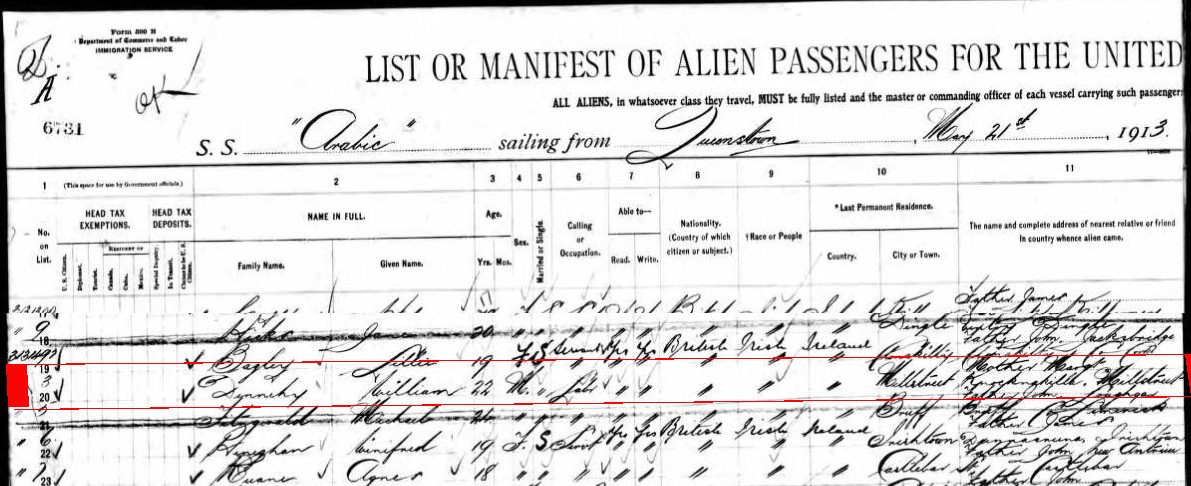
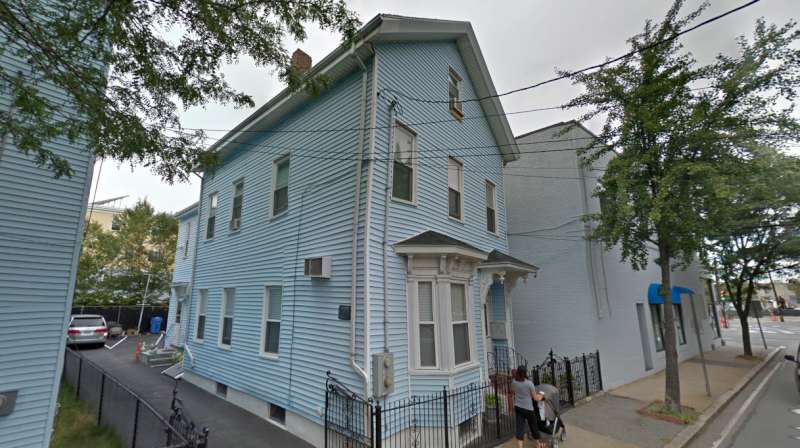
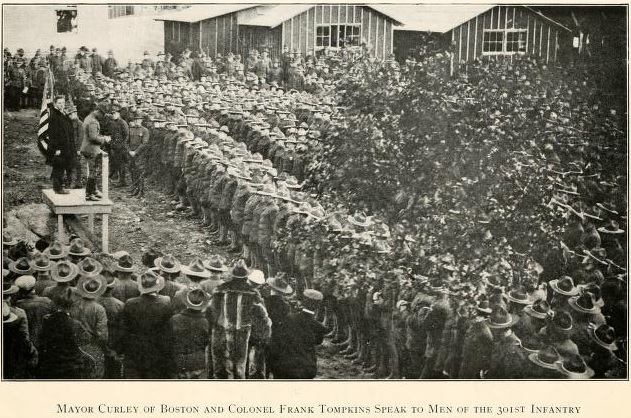
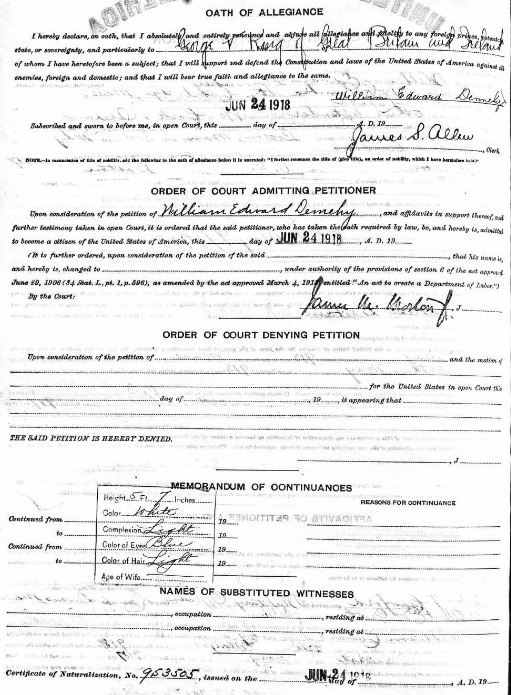
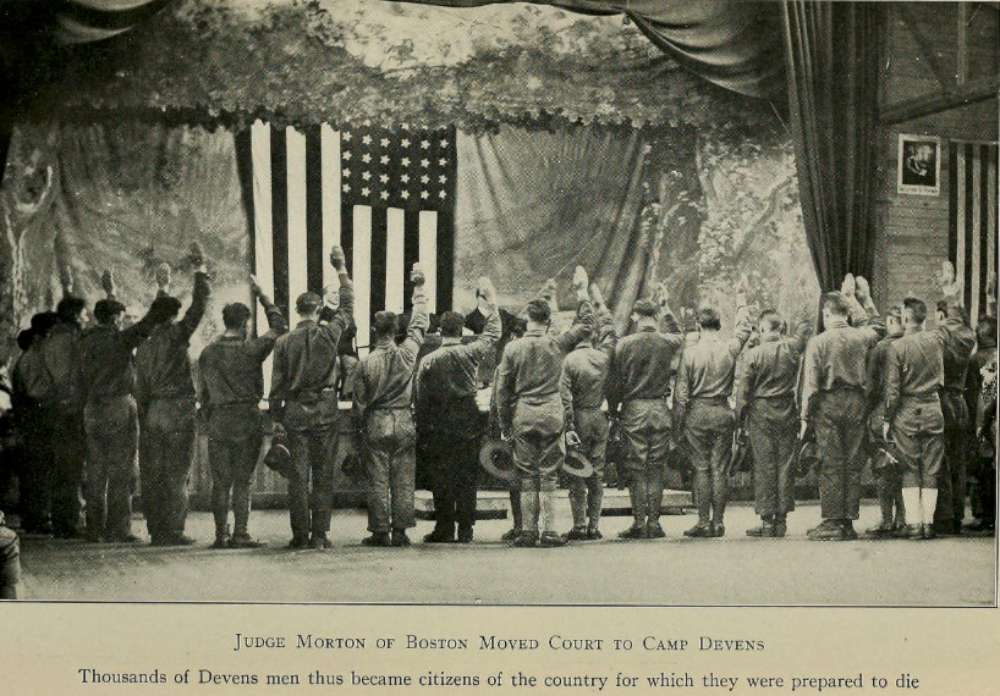







Excellent descriptive piece …. such detail … it really showed the agony of war …such a sad story …. what a dreadful homecoming to his mother brother and sister … and so near the end of the war rip in Drishane William Dennehy .
Here is his mother Margaret and brother Jeremiah’s headstone
http://historicgraves.com/drishane/co-drsh-0151/grave
and maybe somebody can confirm, I think this may be his sister Mary’s husband and sons
http://historicgraves.com/drishane/co-drsh-0166/grave
Your correct Mary, Margaret Dennehy is buried with her 2 sons (William and Jeremiah) also daughter Mary. Jeremiah’s wife Julia is also in the grave.
Mary’s husband and sons are in the other grave.
We are battling to have our brother Lance Corporal Paul Denehey repatriated to Australia after he was buried in Singapore while serving in the Special Air Service in Borneo 1965 after being gored by an elephant and suffering for days and dying alone in the jungle. We have Facebook page:
https://www.facebook.com/groups/2392166247673329/
https://vwma.org.au/explore/people/617184